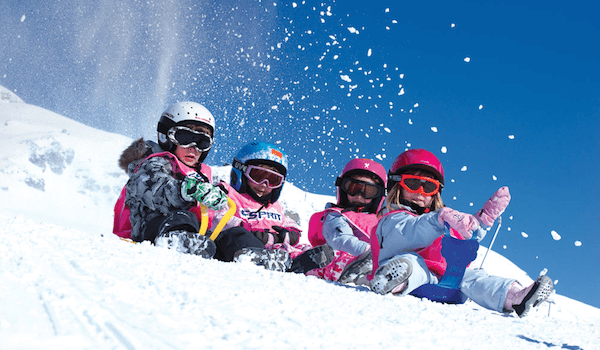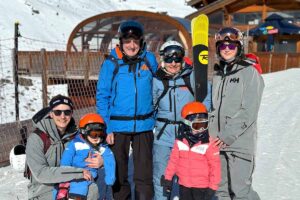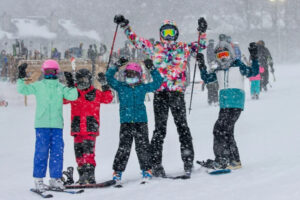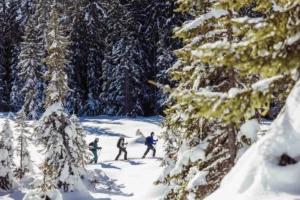
Just because you’ve got children, doesn’t mean you shouldn’t go family skiing. Maybe the thought of it brings you out in the cold sweat. First there’s the travel, then there’s all the clothing, and the boots, and skis and the poles. And the cold. And the traumas for children at ski school. And the chance of injury. And that’s before you’ve even considered the cost. It’s no wonder most people quickly decide that a ski holiday with their family is way beyond their means.
Which is a pity – because they’re really missing out. Skiing is a sociable activity you can do with your children whatever their ages, and at ski school they’ll make friends easily when everyone is falling around and laughing together. And, for parents, almost nothing can beat the sensation of seeing your children make their first linked turns down the mountain. Pretty soon, your collective confidence is going to soar.
How soon can we start them skiing?
The Norwegians habitually start their children on skis when they’re three – and I’ve known British parents push their brood onto the slopes when they’re still in their nappies. But I wouldn’t recommend it – you risk putting them off for years to come. Far better to wait until they’re more physically capable – somewhere between the ages of five and eight.
Should we look for expert assistance?
In a word, yes. Getting a couple of children dressed, breakfasted, booted, and off to ski school each morning complete with lift pass, skis, helmet, mittens and a pair of goggles is hard work. Getting all four of you there on time and into separate ski classes is virtually impossible – so you need expert help.
What kind of services should I look for?
These are the important ones:
Nurseries and creches for the non-skiing under-fours. Ideally, these should be operator-run, and staffed with qualified British or English-speaking nannies, and provide full-day care with lunch.
English-speaking ski school classes, or those which are run exclusively for the younger guests of a tour operator. (Failing that, look for operators which post at least one member of staff at the local ski school to provide support and deal with problems on the spot.) Staff should also be on hand to escort your children to school, and bring them back again.
Supervised lunches for children who’ve been to ski school, followed by an afternoon activities club, run and staffed by the operator. (Most under-eights may be happy to go to ski lessons in the morning, but few will have the energy for a whole day on the slopes.)
A high tea, served before the adults’ dinner.
Sunday-to-Sunday travel. (Airports are quieter, and the traffic to the resorts lighter, which helps keep transfer times down.) Or go all the way there by train, which avoids any delays.
What kind of accommodation do we need?
Most important is your proximity to the nursery slopes, and the ski school rendezvous point. Or, failing that, a place which offers a free shuttle service to them. But whether you plump for an apartment, hotel or chalet is more a matter of your tastes, budget and your family’s way of doing things.
Hotels may sound formal, but there are plenty in the Alps which are family friendly and have a relaxed atmosphere. If you are taking a baby or toddler they can even pre-book extras such as cots and high-chairs.
Check whether evening babysitting is available so that you can escape when you need to. An in-house creche, larger than normal ‘family bedrooms’, or two linked rooms are big bonuses.
Apartments provide flexible accommodation best-suited to families with older children, allowing the option of eating in or out each evening. Cooking for your family saves money and it is fun – as well as educational – to shop in foreign supermarkets.
Chalets can be a home-from-home, provided you manage to fill one with your own family and friends. That way, you won’t have to worry about your noisy children running around and disturbing other guests. The living areas usually have satellite TV and CD players; some even have games rooms and other useful extras. Always check that an early children’s supper is provided – and it’s worth asking if the chalet staff will babysit for an extra fee.
Which resort should I aim for?
Check out our best resorts for family skiing for the pick of where to go. If you can’t manage to get in to one of these, look for resorts that are no more than two and a half hours transfer time from the airport, and which offer plenty of back-up facilities, such as tobogganing, snow-tubing ice-skating, swimming-pools, maybe even dog-sledding and sleigh rides – in case your children don’t like the cold or don’t take to skiing.
Snowmobiling is popular with slightly older children. Look for resorts with groomed trails and guided evening tours.
How can we avoid the school holiday crowds?
It’s not easy. But there are three main ways to avoid the school-holiday crush. The first is to choose a resort with a really modern lift system (such as Tignes) that can cope with large numbers swiftly and efficiently. The second is to opt for a lesser-known resort (such as La Tania, Vaujany, or Ardent) which is part of a bigger ski area. The third is to go for a resort off the beaten track (such as Sun Peaks, Geilo or La Rosiere).














Via @welove2ski – Does the thought of taking children skiing bring on a cold sweat? https://t.co/0DfNIKmj <Good tips; just ignore the ads 😉
RT @welove2ski: Does the thought of taking children skiing bring you out in a cold sweat? https://t.co/sXIal2cP
RT @welove2ski: Does the thought of taking #children #skiing bring you out in a cold sweat? https://t.co/C4TlgJzf
Family skiing can be great fun if you get it right! Hiring the kids ski wear makes good sense as well and saves a… https://t.co/AqkzseKK
It may be summer but for those thinking of taking the family #skiing this winter, this article has some good pointers: https://t.co/gaSNPr7a